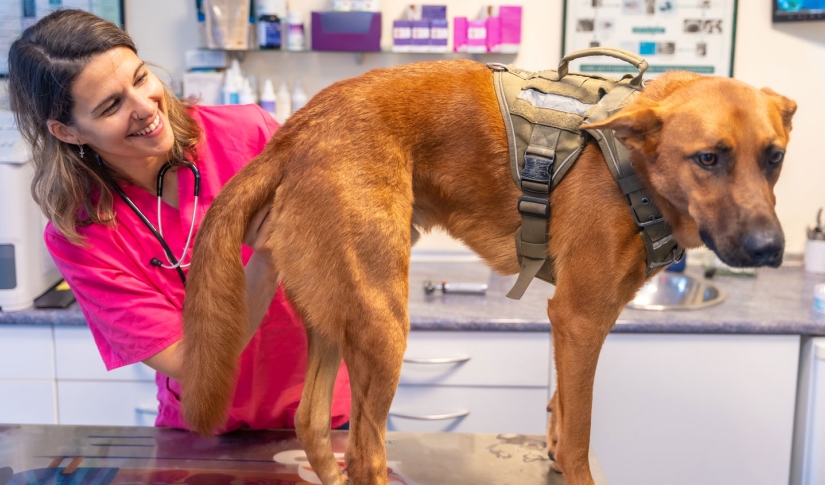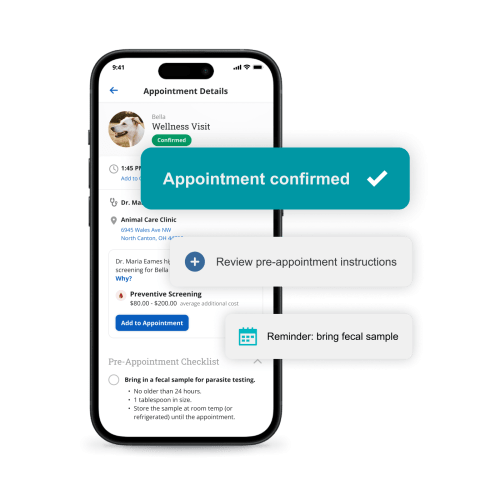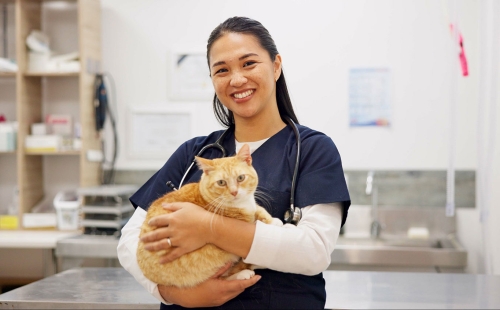Building a Fear Free Veterinary Practice: Prioritizing Pets’ Emotional Well-Being

Veterinary visits can be inherently stressful for pets, who can be overwhelmed by unfamiliar sights, sounds, and smells. Restraint, painful procedures, and separation from trusted family members only worsen the situation. Plus, pet owners who recognize their pets’ anxiety may become anxious themselves or avoid vet visits entirely.
Fear Free® veterinary practice is a game-changing approach that focuses on reducing pet fear, anxiety, and stress associated with veterinary visits. A comfortable, calming environment where pets feel safe improves health outcomes, builds pet owner trust, and increases veterinary professionals’ job satisfaction.
Individuals and veterinary hospitals can join the movement by becoming Fear Free Certified®. The course covers detailed strategies for reducing pet stress and provides resources for implementation. In the meantime, here’s a look at basic Fear Free tenets and small changes you can make toward building a Fear Free practice.
What is Fear Free?
Founded by Dr. Marty Becker in 2016, Fear Free prioritizes animals’ emotional well-being as an integral component of physical health. The program offers training and certification for veterinary teams to help ensure their veterinary care is a positive experience for pets. Fear Free practitioners also focus on client education to help pet owners understand how fear, anxiety, and stress impact a pet’s mental and physical well-being.
Fear Free veterinary practice principles
The Fear Free experience is positive and welcoming for pets, pet owners, and veterinary teams. Here are some basics of Fear Free visits:
- Pre-visit preparation — Fear Free starts at home. Clients receive tips for acclimating pets to their carrier and car to minimize travel stress. Some pets may benefit from “happy visits,” where they get treats at the practice and go home with a wagging tail. Many pets require pre-visit medications, most commonly trazodone or gabapentin.
- Relaxing environment — A Fear Free environment accounts for every detail, including visual, auditory, and olfactory stimuli. Pheromones, calming paint colors, soothing music, separate dog and cat waiting areas, soft lighting, boxes for cats to hide, comfortable furniture, recessed scales, and flooring and table surfaces with good traction combine to create a calming space.
- Gentle handling — Towel wraps, minimalist restraint techniques, chemical restraint, and specific examination techniques help most pets accept restraint. However, for pets still upset by restraint, the team will try a different tactic.
- Positive reinforcement — Pets should visit Fear Free practices hungry, so the team can offer a constant stream of treats that helps the pet form a positive association with visits, restraint, and procedures. Over time, pets look forward to visits and willingly participate in their care.
The benefits of Fear Free veterinary practice
Embracing the Fear Free philosophy can transform your entire veterinary practice. Here are a few of the many benefits of prioritizing pet emotional wellness:
- Accurate diagnostics — Calm pets have more accurate heart rates, blood pressures, temperatures, and lab results.
- Loyal clients — Many clients avoid vet visits for fear of their pets being roughly handled and traumatized. With Fear Free, clients can see the difference in their pets and keep returning.
- Healthier teams — Wrestling anxious pets against their will takes an emotional and physical toll on veterinary teams. Fear Free practice eliminates this disconnect, and employees feel good about their impact on patients.
Getting started with Fear Free veterinary practice
Here are some tips to start building a Fear Free veterinary practice:
- Get certified — Choose select team members, or opt for the entire team, to complete the Fear Free training course.
- Walk through your space — Walk through your clinic from the pet’s point of view. What might cause them stress? Easy first changes include eliminating crowds in the lobby, adding non-slip mats, and placing pheromone diffusers throughout.
- Commit to Fear Free — Fear Free practice works only when the team is on board. Appoint a Fear Free “champion” who helps individuals transition from old protocols and handling techniques to new ones.
- Leverage software — Modern software is customizable, so you can create “emotional records” for pets, including each pet’s favorite treats, pre-visit drug doses, and best restraint techniques.
Fear Free veterinary practice helps your clinic stand out from the rest and helps your team feel good about providing compassionate veterinary care. Ensure the whole veterinary team is committed to Fear Free protocols and then begin with small changes that mean better care for clients and pets—and your team.




